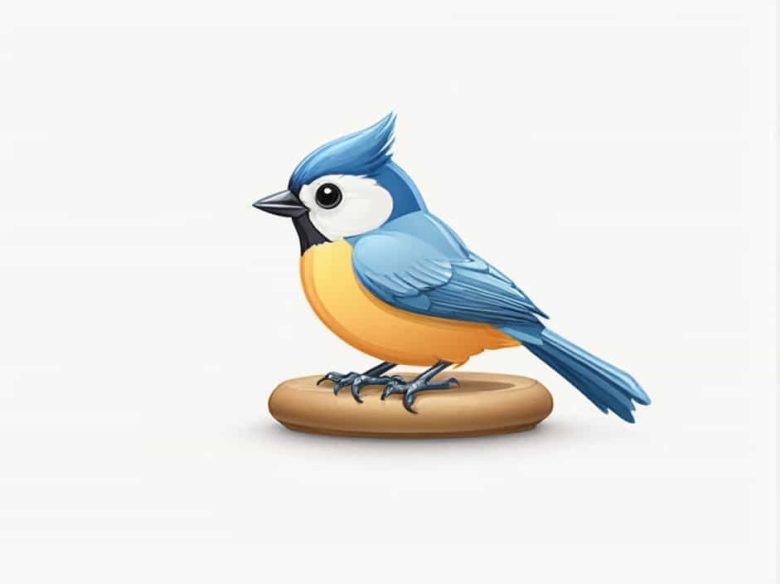The titmouse is a small lively bird known for its soft gray plumage expressive black eyes and distinctive crest on its head. Found across North America these birds are common visitors to backyard feeders and are admired for their playful behavior and melodic calls.
In this topic we will explore the appearance habitat diet behavior and interesting facts about titmice. Whether you are a birdwatching enthusiast or just curious about these fascinating creatures this guide will help you appreciate the beauty of the titmouse.
1. What Does a Titmouse Look Like?
The titmouse belongs to the Paridae family which includes chickadees and other small songbirds. The most well-known species in North America is the Tufted Titmouse (Baeolophus bicolor).
Key Features of a Titmouse
- Size: Small about 5.5 to 6.3 inches (14-16 cm) in length.
- Color: Mostly gray on the upper body with a white belly and a rust-colored patch on the flanks.
- Crest: A noticeable tuft of feathers on the head giving it a distinctive appearance.
- Eyes: Large round and black making them look alert and expressive.
- Beak: Small but strong perfect for cracking seeds and nuts.
The titmouse has a curious and friendly expression often tilting its head while observing its surroundings.
2. Where Do Titmice Live?
Titmice are non-migratory birds meaning they stay in their habitats year-round. They are commonly found in:
- Deciduous forests
- Mixed woodlands
- Parks and suburban areas
- Backyards with bird feeders
These birds prefer areas with plenty of trees for nesting and open spaces where they can search for food.
3. What Do Titmice Eat?
The diet of a titmouse consists of seeds nuts berries and insects. Their strong beaks allow them to crack open hard shells making them frequent visitors to backyard feeders.
Favorite Foods of Titmice
- Sunflower seeds
- Peanuts
- Suet
- Insects (caterpillars beetles ants and spiders)
- Berries and small fruits
Titmice often store food by hiding seeds in tree bark or other crevices a behavior known as caching.
4. Titmouse Behavior and Personality
Titmice are active curious and social birds that often travel in small flocks especially in winter.
Common Behaviors
- Bold and inquisitive: Unlike some shy birds titmice are not afraid to explore new areas.
- Acrobatic flyers: They can hang upside down while searching for food.
- Melodic singers: Their song is a repeated “peter-peter-peter” which is loud and clear.
- Interacts with other birds: Titmice often join mixed flocks with chickadees nuthatches and woodpeckers.
5. How Do Titmice Nest and Reproduce?
Titmice nest in tree cavities old woodpecker holes or birdhouses. They do not excavate their own holes but rely on existing ones.
Nesting Facts
- Breeding season: Spring (March to June).
- Nest location: Inside tree holes or specially designed nest boxes.
- Materials used: Moss grass fur and feathers (sometimes plucked from live animals).
- Eggs laid: 5-7 white eggs with reddish-brown spots.
- Incubation period: About 12-14 days with the female taking care of the eggs.
After hatching both parents feed and protect the chicks until they are ready to leave the nest in 2-3 weeks.
6. Interesting Facts About Titmice
- They remember where they store food. Titmice have a great memory allowing them to retrieve hidden seeds later.
- They are not shy. Unlike some birds titmice will often approach humans especially if food is offered.
- Their name comes from Old English. The word “titmouse” comes from “tit” meaning small and “mose” meaning bird.
- They can recognize other birds. Titmice have been observed recognizing and responding to individual birds in their flock.
7. How to Attract Titmice to Your Yard
If you want to invite titmice to your backyard follow these simple steps:
Food & Feeders
- Provide black oil sunflower seeds peanuts and suet.
- Use a tube feeder platform feeder or suet cage.
Water Sources
- Place a birdbath in your yard for drinking and bathing.
Shelter & Nesting Sites
- Put up nest boxes with a 1.25-inch entrance hole.
- Keep trees and shrubs in your yard for natural shelter.
8. Conservation Status: Are Titmice Endangered?
The titmouse population is stable and they are not considered endangered. However habitat loss and climate change can affect their food supply and nesting areas.
How to Help Titmice
- Preserve forests and natural habitats.
- Reduce pesticide use to protect insect populations which titmice rely on for food.
- Provide nest boxes and bird feeders to support local populations.
The titmouse is a charming and lively bird that adds beauty and joy to any backyard. With its soft gray feathers distinctive crest and cheerful song it is a favorite among bird lovers.
By understanding where titmice live what they eat and how they behave you can appreciate these wonderful birds even more. If you want to attract them to your yard simply provide food water and nesting spaces and you’ll soon enjoy the company of these delightful songbirds.
